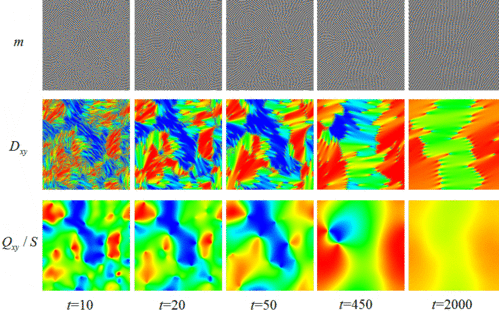

We demonstrate field-induced formation of stripe domains in phase separation accompanying orientational ordering, taking a mixture of an isotropic liquid and a nematic liquid crystal as an example. We can classify spinodal decomposition, which is governed by coupling between conserved compositional and nonconserved orientational ordering, into two types: isotropic and anisotropic spinodal decomposition. In the former, phase separation occurs prior to orientational ordering. Thus, an isotropic phase-separated pattern is formed in the early stage even under an external field. In the latter, on the other hand, a homogeneous oriented phase is formed prior to phase separation under an external field. Then anisotropic domains grow by phase separation. We reveal that the kinetic pathway in the two-dimensional order parameter space is key to field-induced stripe formation. This principle may be commonly applied to a mixture, one of whose components has orientational ordering such as spin, dipolar or orbital ordering. We also confirm that the anisotropic pattern has a memory of orientation of the applied external field, which may be used for device applications.
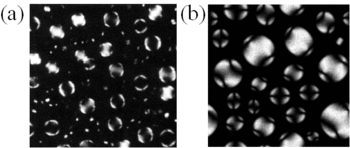
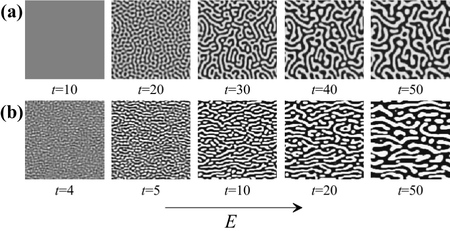
We numerically study phase-separation dynamics of symmetric mixtures of an isotropic liquid and a liquid crystal, incorporating nematohydrodynamics, for the first time.We find that the hydrodynamics not only accelerates the domain growth, but also leads to the breakdown of the morphological symmetry of the two phases, which occupy the same volume: The liquid-crystal-rich phase tends to form isolated domains. This symmetry breaking is revealed to be induced by the flow-alignment coupling due to the anisotropic shape of liquid crystal molecules (kinetic effects), and not by the elastic asymmetry (energetic effects).
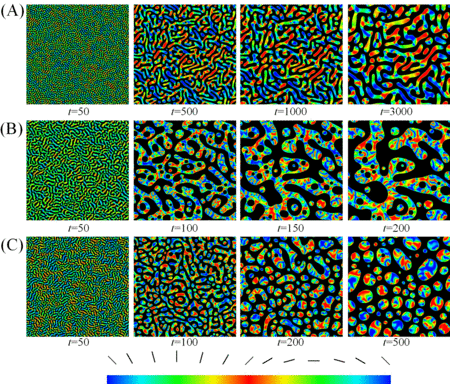
We studied the dynamics of isotropic-nematic transitions in liquid crystalline polymers by integrating time dependent Ginzburg-Landau equations. In a concentrated solution of rodlike polymers, the rotational diffusion constant \(D_r\) of the polymer is severely suppressed by the geometrical constraints of the surrounding polymers so that the rodlike molecules diffuse only along their rod directions. In the early stage of phase transition, the rodlike polymers with nearly parallel orientations assemble to form a nematic polydomain. This polydomain pattern, with characteristic length \(\ell\), grows with self-similarity in three dimensions over time with an \(\ell \sim t^{1/4}\) scaling law. In the late stage, the rotational diffusion becomes significant, leading to a crossover of the growth exponent from 1/4 to 1/2. This crossover time is estimated to be on the order of \(t \sim D_r^{-1}\). We also examined the time evolution of a pair of disclinations placed in a confined system by solving the same time-dependent Ginzburg-Landau equations in two dimensions. If the initial distance between the disclinations is shorter than some critical length, they approach and annihilate each other; however, at larger initial separations, they are stabilized.
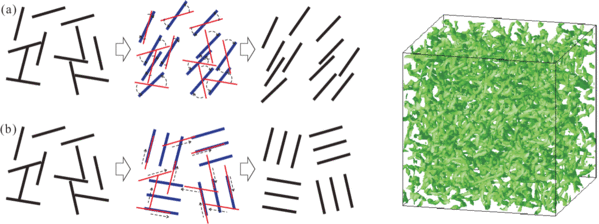
We propose a simple Ginzburg-Landau model for phase transition dynamics in liquid crystals. This model is capable to reproduce phase transitions among isotropic, nematic, smectic A and smectic C phases with controling only a few parameters. On the basis of this model, we also demonstrate numerical simulations. We observed that a polydomain pattern is formed in an early stage of isotropic-smectic A transition and its characteristic length grows in time as \(\ell\propto t^{0.25}\), for example. On the other hand, phase transition into smectic C shows a zigzag pattern, which coarsens in time more slowly as \(\ell\propto t^{0.1}\).
